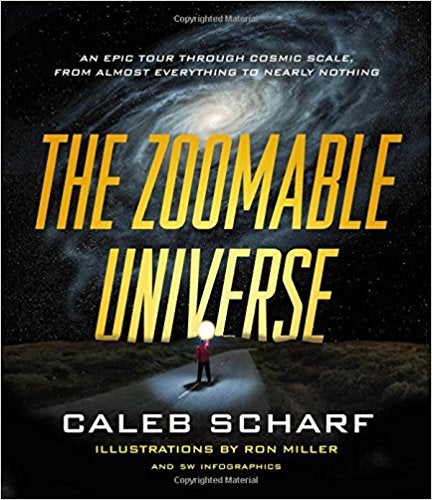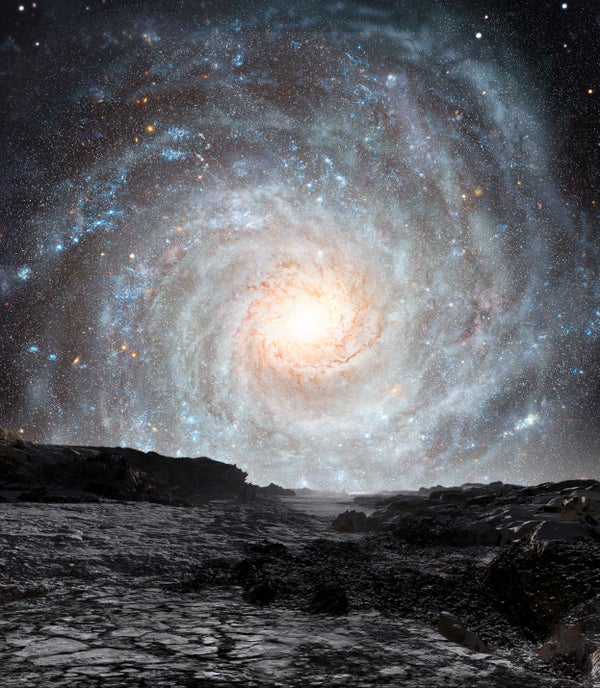This article was published in Scientific American’s former blog network and reflects the views of the author, not necessarily those of Scientific American
Most of us have, at some time or the other, wondered about the nature of existence. Perhaps it’s been during a period of deep contemplation on our place in the swirl of life, a reflection on our own significance and improbability. Or perhaps it’s been after a couple more pints of beer than was really necessary, or during the thoughtful chomping of a cheese doodle at the half-time point of a sporting event.
But it’s hard to really get your mind around it all. The universe is big, really enormously big. Even our home, the Earth, is pretty vast compared to our puny bodies. Yet, at the same time, like all planets, it is merely a droplet of gradually freezing minerals, an afterthought circling one paltry star out of what may be a trillion, trillion stars across the cosmos. And there’s lots more stuff wrapped up inside us, billions of miles-worth of DNA (if you had it all unfortunately extracted and stretched out), and quadrillions of atoms. Inside those atoms the scales continue downwards, through a gulf of emptiness leading to the innermost nooks of Planckian spacetime.
Gulp.
On supporting science journalism
If you're enjoying this article, consider supporting our award-winning journalism by subscribing. By purchasing a subscription you are helping to ensure the future of impactful stories about the discoveries and ideas shaping our world today.
The human brain doesn’t do big numbers, and great extremes so well. We rely on our mathematics to absorb what our senses cannot. Sometimes though we can trick ourselves a little, get a fleeting sense of the true span of physical reality. That can happen when you lean off a balcony on a tall building, or crane your neck to look up at stars in the sky, or witness a flock of thousands of birds swooping and swirling in the cavernous air. In all these cases, for an instant, you can latch onto the contrasts, the before and after, the speck versus the elephant.
That’s a trick that the famous movie (and later book) Powers of Ten used, back in the 1970s. This movie wasn’t alone, before had come Cosmic Zoom by the National Film Board of Canada in 1968, and before that was Cosmic View by Kees Boeke in 1957, and the canny Robert Hooke arguably had them all beat with Micrographiaback in 1665.
It’s also a trick that has just got refreshed and updated with a new book, The Zoomable Universe, by yours truly and the extraordinary illustrator Ron Miller. In the age of online tools and animations – including some marvelous ‘trips through the universe’ in the form of web-apps like The Scale of the Universe – the printed page still has some serious leverage.
In a book (as we discovered) it’s possible to slow things down, to make that fall through physical scale pause a little, to become more comprehensible, even as it continues to shock our mind. Blending state-of-the-art images and information with some meaty text produces a very different effect than either a flick of pages or a finger-swipe of animation. I think that in a very real sense the sheer bulk and complexity of the physical world, as well as its sheer emptiness and strangeness, start to fall into place when it’s all laid out – end-to-end – on a set of good solid pages.
How big and small did we go? We went all the way baby! From the 1027 meters that is the span at this very instant of the cosmic horizon, edge-to-edge, all the way down to 10-35 meters and the choppy, strange spacetime at the Planck scale.
Inside that range are about 1080 particles of normal matter and 1089 photons. That’s all of everything we can ever hope to see. And in the journey of Zoomable, the reader gets to take one very specific path, a trajectory across time and space by factors of ten. That trajectory just happens to intersect with our world, and our little crumb of existence that represents a tiny fraction of those 1080 particles. It could have taken a trillion other routes too. Altogether it’s the ultimate travelogue, but it’s also a reflection on interconnection, questions, and enduring mysteries.
It was fun to construct this journey. It’ll be even more fun to see where it leads us to next.
The Zoomable Universe (Scientific America/Farrar, Straus & Giroux, October 2017)

Credit: Scientific American and FSG
